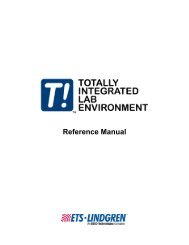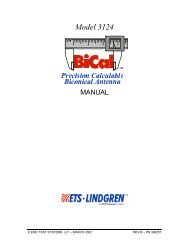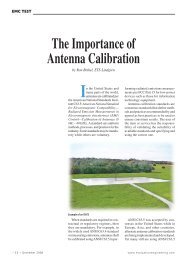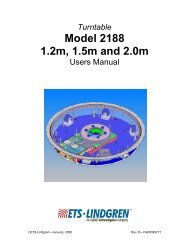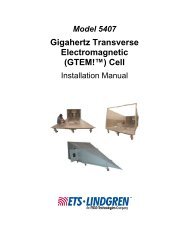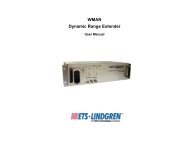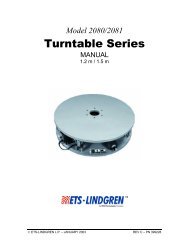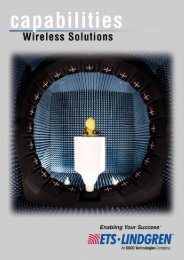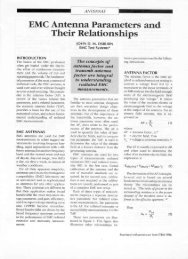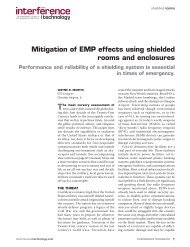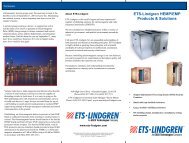Shielding Issues for Medical Products - ETS-Lindgren
Shielding Issues for Medical Products - ETS-Lindgren
Shielding Issues for Medical Products - ETS-Lindgren
You also want an ePaper? Increase the reach of your titles
YUMPU automatically turns print PDFs into web optimized ePapers that Google loves.
<strong>Shielding</strong> <strong>Issues</strong> <strong>for</strong><br />
<strong>Medical</strong><br />
<strong>Products</strong><br />
Basic Magnetic <strong>Shielding</strong> <strong>Issues</strong> <strong>for</strong> MRI Systems<br />
by Benjamin D. Turner<br />
48 Con<strong>for</strong>mity mAy 2007<br />
© Photographer: Chris Ryan | Agency: Dreamstime.com
This article provides the reader with an overview of the<br />
basic principles of magnetic shielding <strong>for</strong> magnetic<br />
resonance imaging (MRI) systems. It pre-supposes only<br />
a rudimentary understanding of magnetic shielding as it relates<br />
to MRI systems, and will explain: 1) why magnetic shielding<br />
is needed <strong>for</strong> an MRI system; 2) what it can consist of; 3) how<br />
magnetic shielding can impact construction and a construction<br />
schedule; and finally and most importantly 4) what an enduser<br />
of the MRI equipment needs to do and/or consider when<br />
first starting to plan <strong>for</strong> an MRI system.<br />
Why Magnetic <strong>Shielding</strong> Is Needed<br />
First, not every MRI system needs magnetic shielding. There<br />
are many different types of MRI systems, and each location<br />
where an MRI system can be placed is different from the<br />
location chosen by some other hospital or clinic.<br />
There are two basic reasons <strong>for</strong> magnetic shielding. First,<br />
magnetic shielding is needed when the proposed location<br />
of the MRI system allows the magnetic field of the MRI<br />
system to extend beyond the MRI scan room itself and into<br />
surrounding areas that could be adversely affected by the<br />
magnetic field from the system.<br />
A typical example of this would be an MRI system that<br />
generates a 5 gauss field (gauss is a unit of measure of<br />
advertisement<br />
magnetic field) that extends into a public area. The U.S. Food<br />
and Drug Administration (FDA) has established guidelines<br />
that either require that the 5 gauss field be kept away from<br />
the unsuspecting public, or the posting of signs that notify the<br />
public of the possible exposure (such as, “you are entering<br />
an area of 5 gauss or higher”). The 5 gauss field has been<br />
established as the boundary line beyond which we should keep<br />
people with pacemakers and other metal implants away in<br />
order to prevent possible harm.<br />
Second, magnetic shielding is needed when the proposed<br />
location of the MRI system is located such that the operation<br />
of the MRI system might be adversely affected by something<br />
around the MRI suite.<br />
A typical example of this might be when an MRI system is<br />
placed in close proximity to automotive traffic, such that the<br />
traffic makes the operation of the MRI system less than ideal.<br />
This would be due to the fact that cars and trucks are made<br />
of ferrous magnetic metals, which can negatively impact the<br />
quality of images generated by an MRI system when too near<br />
to an MRI system. Consult the Site Planning Guide of your<br />
MRI vendor on the acceptable distance your MRI must be<br />
from moving vehicles.<br />
The first cause, that of an MRI generating a field that affects a<br />
surrounding area, is by far the most common. Here are a few
50 Con<strong>for</strong>mity mAy 2007<br />
considerations and examples of things<br />
to look <strong>for</strong> and plan against:<br />
•<br />
•<br />
•<br />
•<br />
•<br />
Get the magnetic field plots of<br />
the MRI system which you are<br />
considering from the equipment<br />
manufacturer. You should get the<br />
“plan” or top view of the plots,<br />
as well as the “side” and “front”<br />
view plots. Many people <strong>for</strong>get to<br />
consider the vertical space they are<br />
planning to occupy. Magnetic field<br />
will extend vertically up and down<br />
and often this is a more difficult<br />
issue to address.<br />
Make sure the plots that you<br />
receive clearly show the 1 gauss,<br />
5 gauss and 50 gauss lines. The<br />
1 gauss field from the MRI will<br />
disrupt TV and/or computer<br />
monitors as well as some other<br />
medical equipment such as CT<br />
scanners. The 5 gauss is <strong>for</strong><br />
protection of “the public,” and<br />
the 50 gauss line is usually strong<br />
enough to erase magnetic media<br />
such as credit cards, facility access<br />
cards, computer hard drives, etc.<br />
Make sure you overlay the<br />
magnetic field plots onto your<br />
architectural plans, both the plan<br />
view drawings and the section or<br />
elevation drawings. It may seem<br />
obvious but make sure the plots<br />
and drawings are to the same scale!<br />
Identify the use and, if possible,<br />
the major types of equipment that<br />
will be in the rooms immediately<br />
around, above and below the MRI<br />
room.<br />
Common items adversely affected<br />
by the MRI fields include CT<br />
scanners, any medical equipment<br />
with an image intensifier, TVs or<br />
computer monitors, and any public<br />
area through which someone with a<br />
pace maker or metal implant could<br />
unknowingly pass.<br />
If you know that the magnetic field<br />
from your MRI system will overlap<br />
into areas that will affect others<br />
around you, seek to move your system<br />
enough to eliminate this conflict.<br />
Alternatively, see if you can move or
change the area/equipment that will be harmed by the MRI’s<br />
magnetic field. When these options are not possible, you will<br />
need to consider options <strong>for</strong> magnetic shielding.<br />
What Magnetic <strong>Shielding</strong> Is Not<br />
First, let’s understand what magnetic shielding is not. It is<br />
not lead shielding and it is not radio frequency shielding.<br />
Lead shielding is <strong>for</strong> shielding against x-rays and is applied<br />
in a “line-of-sight” manner. In other words, lead shielding is<br />
placed directly between the x-ray device and you. Concrete<br />
can also help to shield against x-rays, but consultation with a<br />
physicist is recommended.<br />
Radio frequency (RF) shielding blocks radio wave signals<br />
from entering or exiting a room. RF shielding must be a<br />
complete, 6-sided box in order to work. You must also<br />
understand that radio waves function over a very broad<br />
spectrum. Your MRI system functions in a very specific<br />
frequency; thus your RF shielding should be designed to be<br />
applicable <strong>for</strong> your frequency of interest.<br />
What Magnetic <strong>Shielding</strong> Can Consist Of<br />
Now that we know what magnetic shielding is not, let’s<br />
understand what magnetic shielding is. Magnetic shielding is<br />
any ferrous metal that will attract magnetic fields. Galvanized<br />
steel, silicon steel, even structural I-beams and columns<br />
in a building can all attract magnetic fields. Can you use<br />
any ferrous metal <strong>for</strong> your magnetic shielding? Yes! The<br />
more important question is whether the metal you select is<br />
economical to use.<br />
Different ferrous metals have quite different electromagnetic<br />
properties. A-36 structural steel behaves much differently than<br />
galvanized steel, in a magnetic sense. Different metals also<br />
have different costs. A high nickel alloy, often termed “mumetal,”<br />
is much more expensive on a per pound basis than is<br />
most grades of silicon steel.<br />
So what metals should you use <strong>for</strong> MRI magnetic shielding?<br />
Low carbon steel is the best metal if you will be placing<br />
the material in a very strong magnetic field. For example,<br />
looking at the magnetic plots of the MRI you are purchasing,<br />
approximately what gauss level lies at the wall where your<br />
magnetic shield will be placed? In general, if the field is 30<br />
gauss or higher, you may want to use low carbon steel. If that<br />
gauss level is less than 30 gauss, you may want to use a grade<br />
of silicon steel.<br />
There are two principle properties that one considers when<br />
choosing what type of metal to use <strong>for</strong> a magnetic shield,<br />
permeability and saturation. Permeability is the ability of the<br />
metal to attract magnetic field to it. Saturation is the ability<br />
of the metal to absorb magnetic field within its wall. For<br />
simplicity, we will not differentiate here between magnetic<br />
field and magnetic flux; however, from a technical point<br />
of view, we would say “attract magnetic flux” and “absorb<br />
magnetic flux” over the term magnetic field. For the lay<br />
person, there is little difference between these terms.<br />
Again, choices in magnetic shielding are driven by economics,<br />
that is, cost versus per<strong>for</strong>mance. You can use other metals,<br />
but you may need to use a greater quantity of one material<br />
to achieve the same per<strong>for</strong>mance of another. Thus, a less<br />
expensive metal may not be least expensive when you<br />
consider how much total material you may need to reach the<br />
same per<strong>for</strong>mance of a more expensive metal.<br />
Further, you cannot always assume that if you use twice or<br />
three times the amount of one material, you will equal the<br />
advertisement<br />
mAy 2007 Con<strong>for</strong>mity 51
shielding effectiveness of another material. For example, it<br />
is a falsehood to say “if I use twice as much silicon, it will<br />
be the same as low carbon steel.” While such a metric may<br />
have applied in a single instance or application, it cannot be<br />
assumed that it will always be true in other situations. This is a<br />
common mistake, but one that is easy to avoid.<br />
Magnetic shielding is not only dependent upon what type of<br />
material you choose but also the physical geometry of the<br />
shield relative to your magnet. Also remember that there are<br />
many different types of magnets, including 0.23T, 0.5T, 1.0T,<br />
1.5T, 3.0T, open, closed bore, and so on. Thus, a magnetic<br />
shield used <strong>for</strong> one MRI system at one location may not work<br />
<strong>for</strong> your MRI system or your location. The physical position<br />
of the magnetic shield metal and the amount of magnetic field<br />
that it is placed in and the goal of your magnetic shield may all<br />
be different from the situation in some other location.<br />
In summary, MRI system magnetic shielding is typically done<br />
with low carbon steel or silicon steel. Low carbon steel works<br />
best if it is heat treated (also called “annealed”); however, if<br />
the material is too thin you will be unable to heat treat it, since<br />
the physical shape of the metal will be altered and thus not fit<br />
nicely in the construction. From a magnetic standpoint, the<br />
lower the carbon content, the better the material. The industry<br />
standard <strong>for</strong> MRI shielding is 0.08% maximum carbon<br />
content, which is denoted as “C1006 steel.”<br />
The most common <strong>for</strong>m of silicon steel used <strong>for</strong> MRI<br />
shielding is trans<strong>for</strong>mer grade, and will range from M19 to<br />
52 Con<strong>for</strong>mity mAy 2007<br />
M36. These are U.S. terms <strong>for</strong> the level of the trans<strong>for</strong>mer<br />
grade material. There are, obviously, equivalents <strong>for</strong> M19 and<br />
M36 in Europe and Asia. Un<strong>for</strong>tunately there are too many<br />
such equivalents to list here.<br />
The Impact of <strong>Shielding</strong> on Construction and Schedule<br />
Magnetic shielding can vary greatly depending upon your<br />
situation (MRI type, location, what you need to shield <strong>for</strong><br />
around your MRI suite, etc.). Magnetic shielding can be<br />
as simple as a small amount of metal on a single wall, or<br />
multiple layers of shielding on some or all walls, ceiling and<br />
floor. Weights of magnetic shielding can vary from a few<br />
hundred pounds to over a hundred U.S. tons. Obviously, space<br />
limitations, as well as the ability to structurally support and to<br />
physically maneuver such material into your planned MRI site<br />
can be difficult.<br />
There<strong>for</strong>e, it is essential that you understand and define how<br />
much magnetic shielding you will need as early as possible in<br />
your planning process. In fact it should be one of, if not the<br />
very first step you take after selecting which MRI system you<br />
are purchasing.<br />
Defining what you need <strong>for</strong> magnetic shielding can greatly<br />
impact your planned cost and construction schedule. For<br />
example, if you determine that you need magnetic shielding in<br />
large amounts above your MRI scanner, but you have already<br />
completed your ventilation, lighting and ceiling plans and<br />
have no space <strong>for</strong> the magnetic materials or the supports need
<strong>for</strong> the magnetic materials, you now have a bigger problem,<br />
particularly if you are already in the construction phase.<br />
Failing to anticipate the need <strong>for</strong> magnetic shielding is only<br />
part of the problem. Magnetic shielding is not always a<br />
logistical challenge, but it can be. You may need <strong>for</strong>klifts,<br />
man-lifts, cranes, etc., or you may need to address the<br />
potential impact of welding fumes or the noise from hand<br />
tools within an actively functioning hospital or clinic all<br />
around the MRI suite.<br />
You should plan <strong>for</strong> 4 weeks <strong>for</strong> manufacturing <strong>for</strong> any<br />
low carbon steel shielding that you need, while silicon steel<br />
typically will require between 2 and 4 weeks. But note that<br />
these are manufacturing times only, that is, after the design<br />
of the magnetic shielding has been completed. Installation<br />
of magnetic shielding can range from 2 additional days to as<br />
much as a month and a half, depending upon the extent of the<br />
magnetic shielding needed.<br />
Planning Considerations <strong>for</strong> an MRI System<br />
Finally, what should an end-user do or consider when starting<br />
to plan <strong>for</strong> an MRI system <strong>for</strong> his or her facility? The first<br />
step is to select an architect. Meet with and review the plans<br />
and proposals of the various companies manufacturing MRI<br />
systems. Each company should be able to give you an idea of<br />
what magnetic shielding will be needed be<strong>for</strong>e you settle on<br />
advertisement<br />
which MRI system you want to purchase. Certainly, they can<br />
provide you with a final magnetic shield design upon selecting<br />
their system <strong>for</strong> purchase.<br />
Consult a shielding company either just be<strong>for</strong>e or just after<br />
your selection of an MRI system. You should consider<br />
contracting with the shielding company to assist you in the<br />
planning and budgeting of the shielding be<strong>for</strong>e it is finalized<br />
by the MRI company. This will enable you to realize the<br />
various cost, scheduling and logistic issues associated with<br />
the magnetic shield early on. With this in<strong>for</strong>mation, you have<br />
a better chance of setting a firm construction budget and<br />
timeline.<br />
Magnetic shielding <strong>for</strong> an MRI system is not a difficult thing<br />
to plan <strong>for</strong>. But it should not be overlooked and thrown in late<br />
in the construction process. Some shielding companies can<br />
provide magnetic shield design services prior to your selection<br />
of an MRI system, thus enabling you to take the shielding<br />
needs of one system versus another into consideration be<strong>for</strong>e<br />
finalizing your purchasing decision.<br />
Benjamin Turner is vice-president of sales and marketing<br />
<strong>for</strong> <strong>ETS</strong>-<strong>Lindgren</strong> and can be reached at<br />
BDTurner@lindgrenrf.com.<br />
FAST Link www.con<strong>for</strong>mity.com/0560<br />
mAy 2007 Con<strong>for</strong>mity 53



